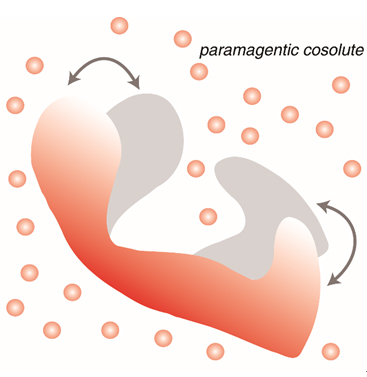Solution NMR can be used to resolve proteindynamics in solution which close to the physiological environment. In the post-structural biology era with new type of frozen electron microscopy turned out, solution NMR is an important bridge connecting the structure and function of proteins from a dynamic point of view. Recently, studies of marker-free paramagnetic magnetic technology to investigate protein dynamics from Prof. Chun Tang’s lab in WIPM entitled “Protein Structural Ensembles Visualized by Solvent Paramagnetic Relaxation Enhancement” is published in Angew. Chem. Int. Ed (http://onlinelibrary.wiley.com/doi/10.1002/anie.201609830/full)
As the saying goes, “life is movement”. Protein as the basic unit of life, which itself is in the dynamic process of continuous movement. As a performer of life activities, proteins can only perform specific biological functions by its dynamics, therefore, the understanding of the dynamic changes in protein structure is the key to understanding its functions. However, by the constraints of research methods, the study of protein dynamics is far behind its structural research.
The paramagnetic relaxation enhancement (PRE) method can obtain structural information inversely proportional to the six power of the distance that is sensitive to capture the dynamic properties of proteins. However, the traditional PRE method requires the labeling of the paramagnetic probe on the protein, which is difficult to operate. The research team developed a marker-free paramagnetic magnetic technology that does not require a paramagnetic probe attached to protein, but add the paramagnetic probe (have been authorized by national invention patent) directly into the protein solution samples. When the small probes and proteins collide with elastic, the amino acids locate in the surface of protein will obtain more relaxation enhancement effect than the inside amino acids. Thus, the small molecule probe has become an objective “observer”, can be accurate and convenient access the structure information of proteins in solution. When the structure of protein in solution keep changing, the small “observer” can access different parts of protein for different conformation, resulting in different PRE effect. Based on this principle and integrate molecular dynamics simulation sampling and the Monte Carlo simulated annealing method, the new method can reproduce the dynamic distribution of protein in solution.
Associate Professor Zhou Gong from WIPM is the first author of this article. This study was funded by the Ministry of Science and Technology、National Natural Science Foundation of China and Howard Hughes Medical Institute (HHMI).
